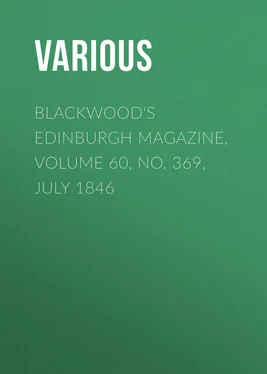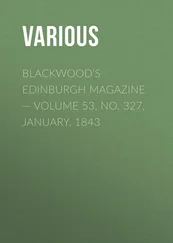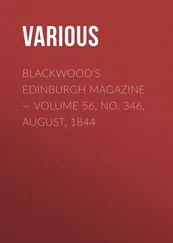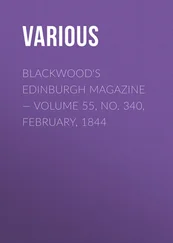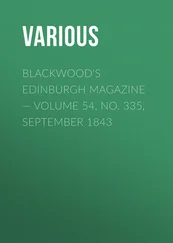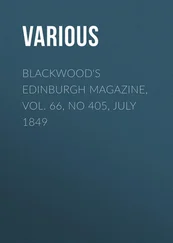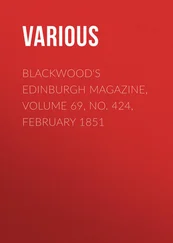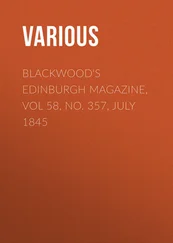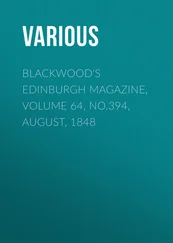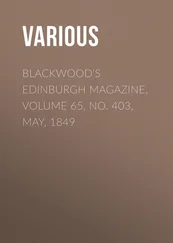Various - Blackwood's Edinburgh Magazine, Volume 60, No. 369, July 1846
Здесь есть возможность читать онлайн «Various - Blackwood's Edinburgh Magazine, Volume 60, No. 369, July 1846» — ознакомительный отрывок электронной книги совершенно бесплатно, а после прочтения отрывка купить полную версию. В некоторых случаях можно слушать аудио, скачать через торрент в формате fb2 и присутствует краткое содержание. Издательство: Иностранный паблик, Жанр: periodic, foreign_edu, Путешествия и география, на английском языке. Описание произведения, (предисловие) а так же отзывы посетителей доступны на портале библиотеки ЛибКат.
- Название:Blackwood's Edinburgh Magazine, Volume 60, No. 369, July 1846
- Автор:
- Издательство:Иностранный паблик
- Жанр:
- Год:неизвестен
- ISBN:нет данных
- Рейтинг книги:3 / 5. Голосов: 1
-
Избранное:Добавить в избранное
- Отзывы:
-
Ваша оценка:
- 60
- 1
- 2
- 3
- 4
- 5
Blackwood's Edinburgh Magazine, Volume 60, No. 369, July 1846: краткое содержание, описание и аннотация
Предлагаем к чтению аннотацию, описание, краткое содержание или предисловие (зависит от того, что написал сам автор книги «Blackwood's Edinburgh Magazine, Volume 60, No. 369, July 1846»). Если вы не нашли необходимую информацию о книге — напишите в комментариях, мы постараемся отыскать её.
Blackwood's Edinburgh Magazine, Volume 60, No. 369, July 1846 — читать онлайн ознакомительный отрывок
Ниже представлен текст книги, разбитый по страницам. Система сохранения места последней прочитанной страницы, позволяет с удобством читать онлайн бесплатно книгу «Blackwood's Edinburgh Magazine, Volume 60, No. 369, July 1846», без необходимости каждый раз заново искать на чём Вы остановились. Поставьте закладку, и сможете в любой момент перейти на страницу, на которой закончили чтение.
Интервал:
Закладка:
The manner in which most of the officers treat the soldiers is perfectly inhuman, and the slightest offences meet with terrible chastisement. Every officer has a right, at least in war time, to inflict, without a court-martial, any punishment he pleases. Some of the chiefs are celebrated for the refinement of their cruelties; and many soldiers prefer death to serving under them. During General Gamarra's campaign against the Bolivians in 1842, several score of soldiers sprang one day from the bridge of Oroya, to seek death in the torrent that flows beneath it. With the scornful cry of " Adios, capitan! " they took the fatal leap, and the next instant lay mangled and expiring upon the rocks through which the stream forces its way. "I myself have witnessed," continues Dr Tschudi, "how soldiers who on the march were unable to keep up with the column, were shot dead upon the spot. On the road from Tarma to Jauja, a distance of nine leagues, I passed seven Indians who had thus lost their lives. It is true that the commandant of that battalion, an officer whose sword was as yet unstained with any blood save that of his own men, was accustomed to call out when he saw a soldier straggling from fatigue – ' pegale un tiro! ' Shoot him down! And the order was forthwith obeyed." When the troops reach the halting-place, and the rabonas learn the fate of their sons or husbands, they mournfully retrace their weary footsteps, and amidst tears and lamentations dig a last resting place for these victims of military tyranny.
The sick are scarcely better treated. When they can no longer drag themselves along, they are placed upon mules, and, through the severest cold or most burning heat, are driven after the army. When they die, which is most frequently the case, they are dropped at the next village, to be buried by the alcalde.
"The major of a squadron of light cavalry," says our traveller, "once asked me, during my stay at Tarma in the year 1842, to take charge for a few days of his sick men. Of one hundred and twenty soldiers composing the squadron, sixty-eight lay huddled together in a damp dark hole, ill of the scarlet fever. Fourteen more were suffering from the effects of punishment. What a horrible sight they presented! Their backs were nearly bare of flesh and covered with the most frightful wounds. A mutiny had taken place, and the major had shot six men, and caused eighteen others to receive from one hundred to three hundred lashes, with broad thongs of tapir hide – a punishment so severe, that some of them died under its infliction. The survivors were compelled immediately to mount their horses and follow the squadron. For nine days they rode on in the most terrible agony, and during that time had to cross the Cordilleras. Several of them refused to have their wounds dressed; and it was necessary to use force to compel them. One man implored me with tears to do nothing to improve his state, for that he longed to die. Before they were nearly cured, a march was ordered, and they again had to mount and ride. The consequences of this barbarity were easy to foresee. Before another eight days had elapsed, the squadron was scarcely sixty men strong."
Turn we from such horrors to a more pleasing theme. "Could I suppose," says Dr Tschudi, "that my readers are acquainted with the excellent description of Lima which Stevenson gives in his Travels in South America, 3 3 An Historical and Descriptive Narrative of Twenty Years' Residence in South America. Containing Travels in Arauco, Chili, Peru, and Columbia; with an account of the Revolution, its rise, progress, and results; by W. B. Stevenson. London: 1825.
I would willingly abstain from any detail of the houses, churches, squares, and streets of that capital. But as that esteemed work was published twenty years ago, and is now almost entirely forgotten, I may venture, without danger of repeating things universally known, to give a sketch of the city of Lima." And accordingly, the doctor devotes his fifth chapter to an account of the capital of Peru – an account over which we shall pass lightly, for the double reason, that our readers may be better acquainted with Stevenson's work than Dr Tschudi's countrymen can be supposed to be, and because, if we linger wherever we are tempted so to do in this very pleasant book, our paper will run out beyond any reasonable length. We must glance at the cathedral founded by Pizarro, and which took ninety years in building. Its magnificence and riches are scarcely to be surpassed by those of any other existing church. The high altar boasts of seven silver pillars of the Ionic order, twelve feet high, and a foot and a-half thick; the shrine is seven and a-half feet high, carved in gold, and studded with countless diamonds and emeralds; the silver candlesticks weigh one hundred and twelve pounds each. In connection with the convent of San Pedro, a curious anecdote is told. It belonged to the Jesuits, and was their "Colegio Maximo;" it was known to possess immense wealth, for the richest plantations and finest houses belonged to the order. In the year 1773, the king of Spain, supported by the famous bull of the 21st June of that year, "Dominus ac redemptor noster," sent orders to his South American viceroys to arrest all the Jesuits in one night, ship them off to Spain, and confiscate their wealth. The greatest secresy was observed, and no one but the viceroy, and those in his entire confidence, was supposed to know any thing of the plan. But the same ship which conveyed to the viceroy the king's instructions in his own handwriting, brought to the vicar-general of the Jesuits in Lima the needful instructions from the general of the order at Madrid, to whom his Majesty's designs had become known. In all silence, and with every precaution the needful preparations were made; at ten o'clock on the appointed night, the viceroy summoned his council, and communicated to them the royal commands. No one was allowed to leave the room till the blow had been struck. At midnight trusty officers were sent to arrest the Jesuits, of whose names the viceroy had a list. It was expected that they would be surprised in their sleep. The patrole knocked at the door of the San Pedro convent, which was immediately opened. The commanding officer asked to see the vicar-general, and was forthwith conducted into the principal hall, where he found the whole of the order assembled, waiting for him, and ready to depart. Each man had his portmanteau packed with whatever was necessary for a long voyage. In all the other convents of Jesuits similar preparations had been made. The astonishment and vexation of the viceroy may be imagined. He immediately sent off the whole fraternity to Callao, where ships were ready to receive them. Inventories were then taken, and search made for the Jesuits' money. But great was the surprise of the searchers when instead of the millions which the order was known to possess, but a few thousand dollars were to be discovered. All the keys, including that of the strong box, were found, duly ticketed, in the vicar-general's room. The Jesuits could hardly have taken a better revenge for the treachery that had been used with their order.
It was supposed that the money was buried, partly in the plantations, and partly in the convent of San Pedro. An old negro, in the service of the convent, told how he and one of his comrades had been employed during several nights in carrying, with bandaged eyes, heavy sacks of money into the vaults beneath the building. Two Jesuits accompanied them, and helped them to load and unload their burdens. The researches hitherto made have been but superficial and imperfect; and Dr Tschudi opines, with some naïveté, that the hidden hoard may yet be discovered. We cannot partake his opinion. The cunning Jesuits who concealed the treasure will have found means to recover it.
Lima was the principal seat of the Inquisition upon the west coast of South America, and in severity the tribunal was but little surpassed by that of Madrid itself. The building in which it was held still exists, but was gutted by the populace when the institution was abolished by the Cortes, and few traces of its internal arrangements and murderous engines are now to be seen. More visible ones are yet to be noticed in the persons of some unfortunate Limeños. "A Spaniard," Dr Tschudi tells us, "whose limbs were frightfully distorted, told me, in reply to my inquiries, that he had fallen into a machine which had thus mangled him. A few days before his death, however, he confided to me that in his twenty-fourth year he had been brought before the tribunal of the Holy Inquisition, and by the most horrible tortures had been compelled to confess a crime of which he was not guilty. I still shudder when I remember his crushed and twisted limbs, at the thoughts of the agonies which the unhappy wretch must have endured."
Читать дальшеИнтервал:
Закладка:
Похожие книги на «Blackwood's Edinburgh Magazine, Volume 60, No. 369, July 1846»
Представляем Вашему вниманию похожие книги на «Blackwood's Edinburgh Magazine, Volume 60, No. 369, July 1846» списком для выбора. Мы отобрали схожую по названию и смыслу литературу в надежде предоставить читателям больше вариантов отыскать новые, интересные, ещё непрочитанные произведения.
Обсуждение, отзывы о книге «Blackwood's Edinburgh Magazine, Volume 60, No. 369, July 1846» и просто собственные мнения читателей. Оставьте ваши комментарии, напишите, что Вы думаете о произведении, его смысле или главных героях. Укажите что конкретно понравилось, а что нет, и почему Вы так считаете.
